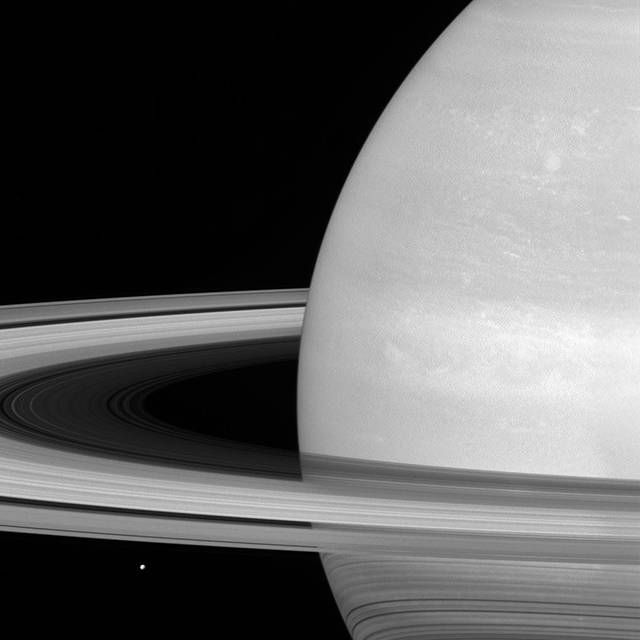By Richard, Everett Public Library staff
When it comes to space travel, both real and imagined, all the attention tends to focus on human expeditions. We see ourselves in a snazzy space suit, preferably with a laser blaster at our side, exploring and colonizing the moon, the planets, and the galaxies beyond. In reality, except for a brief foray to the moon, we haven’t gotten very far. Robots, on the other hand, have been tooling around the solar system and beyond for many years now, dutifully beaming back invaluable information and images for us to enjoy.
A current and spectacular example of robotic exploration is the Cassini mission to Saturn. Cassini has started the final phase of its almost 20 year mission, which has been dubbed ‘the grand finale.’ The probe will be doing a series of tight orbits of Saturn, being the first probe to go between the famous rings of Saturn and the planet proper before ‘completing’ its mission by plunging directly into the planet itself. I was hoping Cassini would be getting a nice retirement, maybe to a farm upstate somewhere, instead of a fiery death, but science is not big on sentimentality, alas.
After gorging yourself on Cassini information, you might want to take a step back and explore the other missions, the importance, and the history of robotic space exploration. The library, as always, has your back. Here are a few resources to get you started on your journey to the final frontier.
Dreams of Other Worlds: the Amazing Story of Unmanned Space Exploration by Chris Impey and Holly Henry
The number of robotic missions in the past 40 plus years makes for quite a long list. Thankfully the authors of this excellent work don’t simply try to run down that list in telling the tale of unmanned space exploration. Instead, they focus on a few key missions and their importance. The Viking and ongoing MER (Mars Exploration Rover) missions to Mars are each given a chapter as well as the Stardust mission to collect samples from a comet. The less glamorous but scientifically invaluable space telescopes Spitzer, Chandra and Hubble are also covered. Throughout the authors impart a sense of wonder and demonstrate the way these missions continue to change our view of the universe and our place in it.
Red Rover: Inside the Story of Robotic Space Exploration, from Genesis to the Mars Curiosity Rover by Roger Wiens
While the incredible results of robotic missions are rightfully lauded to the skies, the actual nuts and bolts of getting the mechanics to work and the mission to succeed are often glossed over. Red Rover is a great corrective, with the author giving you a fascinating behind-the-scenes view of several missions that he has worked on. With the shift away from manned missions beginning in the 1990s, primarily due to cost, robotic missions had to be nimbler and rely on more creative engineering to get off the ground. Wien’s experience demonstrates the triumphs and failures of this endeavor and the general DIY spirit of the teams themselves. If this book piques your interest about the Mars Curiosity Rover, definitely check out some of the other works the library has on the mission.
One of the oldest, launched in 1977 no less, but still ongoing robotic mission is the Voyager program. Currently the Voyager 1 & 2 probes are hurtling through the heliosphere in interstellar space sending back invaluable data and pushing the boundaries of human exploration. For a rundown of the mission itself and the team that continues to work on it, take a look at The Interstellar Age: Inside the Forty-Year Mission by Jim Bell. For a wider view of the mission and how it fits into humanity’s continual quest for discovery definitely check out Voyager: Seeking Newer Worlds in the Third Great Age of Discovery by Stephen Pyne. If you are more visually inclined, take a look at the DVD produced by the BBC titled Voyager: to the Final Frontier. One of the most intriguing aspects of the Voyager mission is the message that was put in it to be discovered by any extraterrestrial life that might happen upon it. The contents of that gold-coated copper phonograph, it was the ’70s after all, can be found in Murmurs of Earth: The Voyager Interstellar Record put together by the people who selected the items meant to represent us, including Carl Sagan.
While it is a bummer that most of us will not be heading to the stars anytime soon, it is a great time to enjoy all the great discoveries and images that our robotic proxies are beaming back to Earth. Plus it’s nice not to die of radiation poisoning. Just saying.
Be sure to visit the Everett Public Library blog for more reviews and news of all happenings at the library.
Talk to us
> Give us your news tips.
> Send us a letter to the editor.
> More Herald contact information.

























